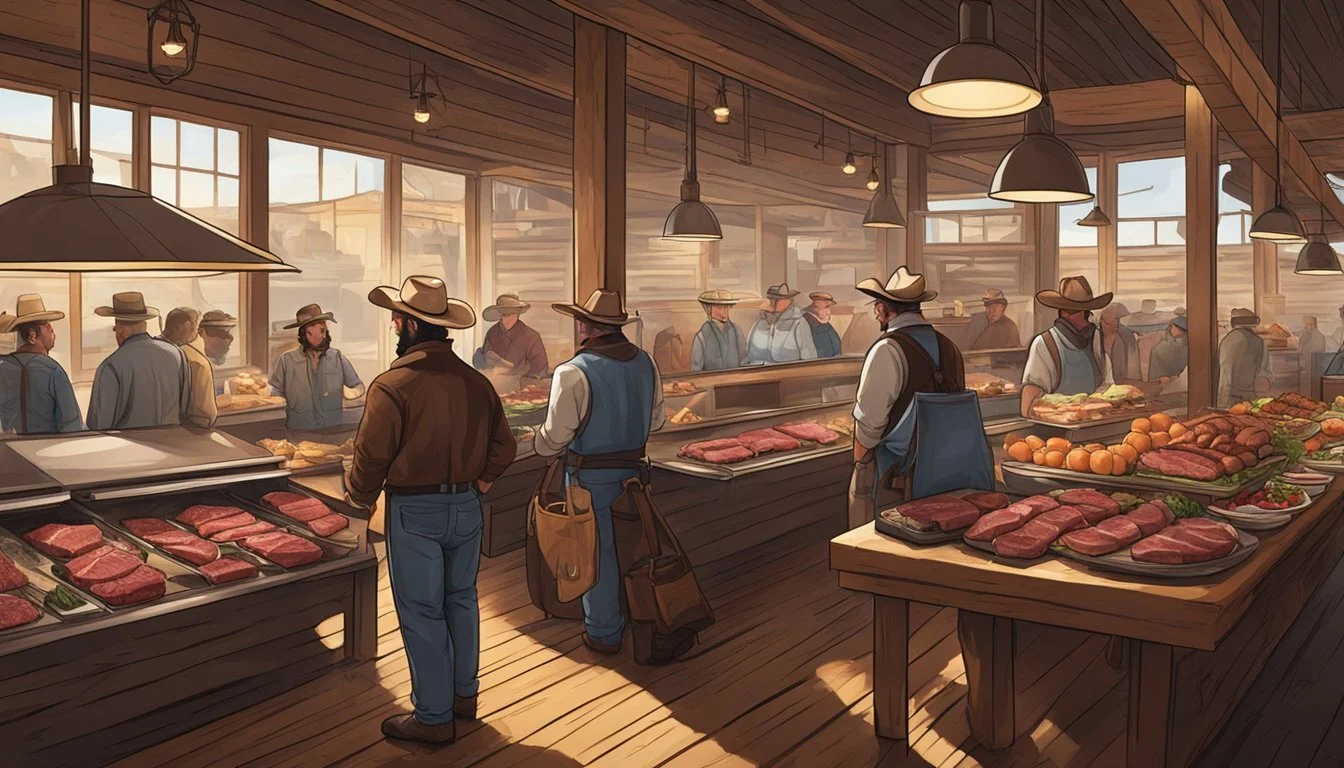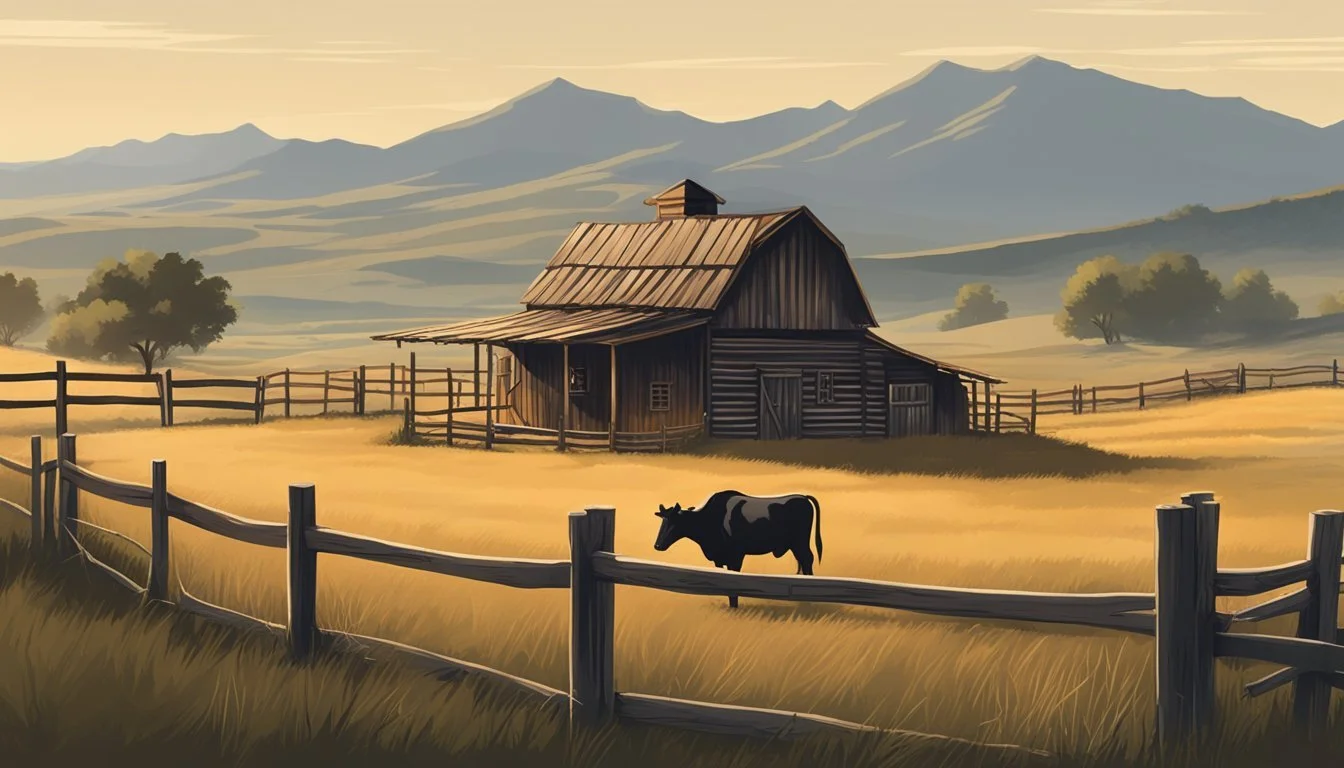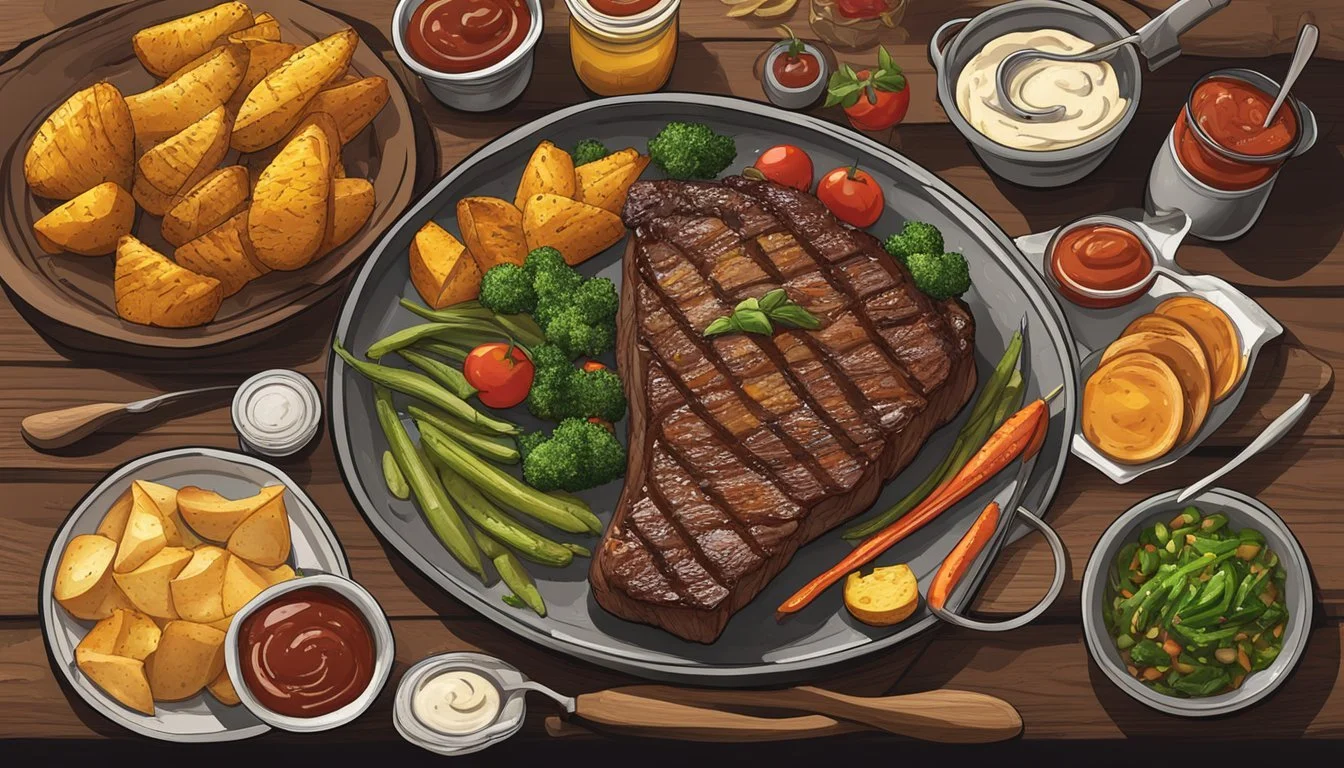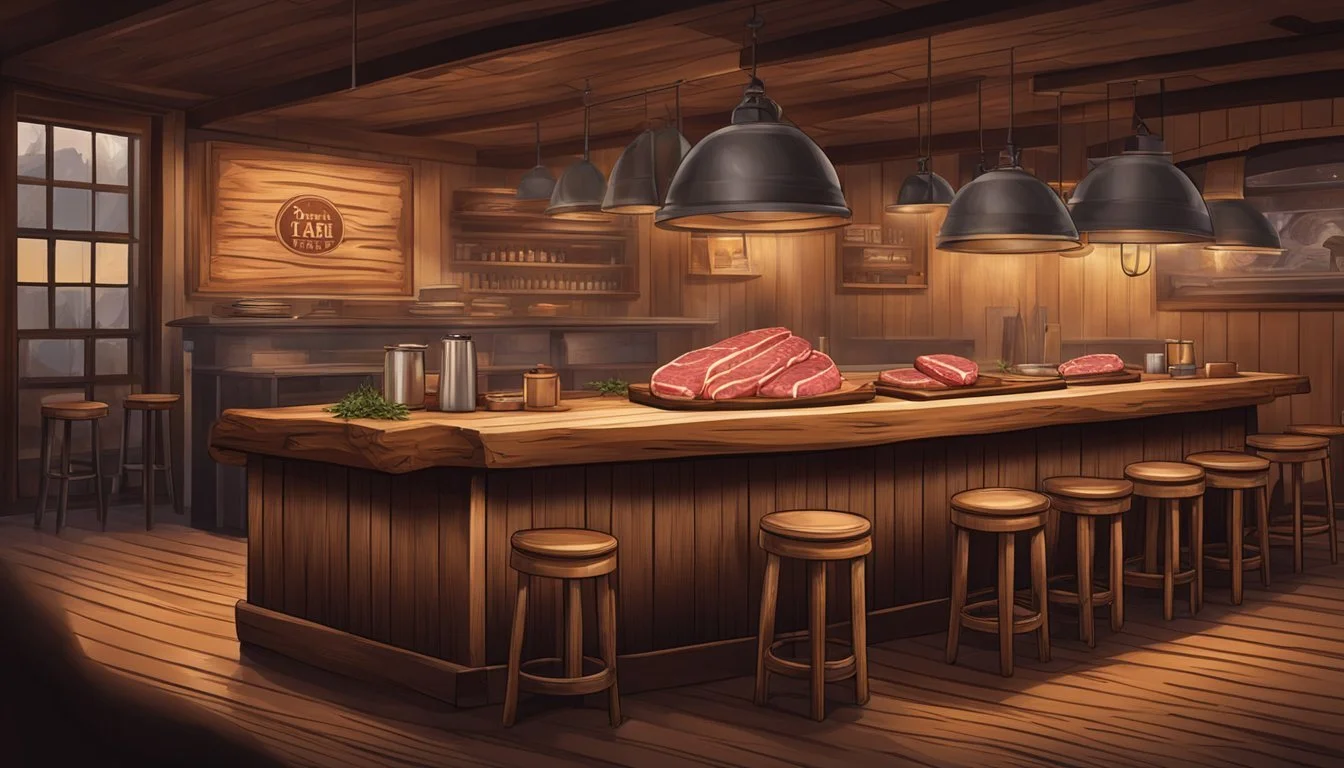The Texas Cowboy's Guide to the Best Steakhouses and Meat Markets
Your Ultimate Carnivore Trail
Texas, affectionately known as the Lone Star State, has long been synonymous with cowboy culture and its rich culinary heritage, where beef is a cornerstone. A true Texas cowboy's palate discerns not only the quality of the meat but also the craftsmanship behind its preparation. From the smoky scent of mesquite-grilled steaks to the thick, marbled cuts served in ranch-style steakhouses, the traditional Texas steakhouse experience is an embodiment of this heritage. These bastions of beef offer not just a meal, but a testament to Texas's history and the cowboy way of life.
Steakhouses across Texas vary from the rustic and storied to the refined and innovative, yet all share a dedication to serving the best cuts of meat. Meat markets, often attached to these eateries or standing alone as local fixtures, provide the freshest selections and the opportunity for patrons to bring a taste of Texas home. At the heart of the experience is the communal aspect of dining, harking back to the days where cowboys would gather around a fire to share stories and enjoy the fruits of their labors.
Selecting the finest steakhouses and meat markets in Texas means stepping into places where the intelligence of choice meets the simplicity of tradition. In these establishments, the preparation of steak is an art form, often accompanied by a glass of fine wine or the local brew. The experience is as much about the ambiance and sense of connection to a bygone era as it is about the pleasure of the palate. For those venturing into the Lone Star State, a visit to its celebrated steakhouses and meat markets is a culinary pilgrimage worth making.
The Roots of Texas Cowboy Traditions
Texas cowboy traditions stem from a rich history of ranching and cattle driving, which remain cornerstones of Texas culture today.
Ranching Heritage and Cattle Ranches
Texas's ranching heritage dates back to the 1800s when vast cattle ranches began to form. Early Texas ranches were influenced by vaqueros, the original cowboys of Spanish origin, renowned for their exceptional herding and horsemanship skills. These ranching operations grew substantial with the advent of cattle drives, where cowboys demonstrated their endurance and grit by driving thousands of cows over long distances to railheads.
Key Entities:
Cattle Ranch: The foundation of cowboy culture, where ranching practices honed the image of the Texas cowboy.
Ranch: Large estates where livestock is raised, the ranch infrastructure supports the rearing and transport of meat to markets.
Steak and Cowboy Steaks
Steaks and cowboy steaks are of great importance in the cowboy diet. Rooted in tradition, cowboy steaks—often ribeyes with the bone-in—exemplify Texan culinary pride. These steaks are typically prepared by grilling, a method that enhances their robust flavors and pays homage to the simplicity and ruggedness of cowboy cooking.
Popular Dishes & Preparation Techniques:
Grilling: Emphasizes the natural flavors of the steak, often chosen for cooking cowboy steaks.
Stew: Hearty and sustaining, commonly enjoyed by cowboys on the trail using a variety of meats, including beef.
Fried Turkey: Although less traditional, it is a testament to the Texans' fondness for substantial and flavorful meat dishes.
Nolan Ryan Beef: Pioneered by the Texan baseball legend Nolan Ryan, this brand of beef is synonymous with quality in the realm of Texas meats, showcasing the blend of tradition and modern ranching practices.
Essential Steak Cuts and Preferences
When it comes to steak cuts, Texas steak enthusiasts typically gravitate towards certain cuts for their texture and flavor profiles. Preferred preparation often includes grilling to a medium rare doneness, which achieves an internal temperature around 130-135°F, allowing the true character of the meat to shine.
Filet Mignon and Ribeye
The Filet Mignon is prized for its tenderness and subtle beef flavor, often preferred by those who enjoy a leaner cut of meat. It's an excellent choice for someone seeking a refined texture without an overwhelming beefy taste. On the other hand, a Ribeye cut offers a more robust beef flavor due to its higher fat content, making it juicier and more flavorful when cooked properly. These cuts are best enjoyed medium rare, to preserve their natural qualities.
Bone-In Ribeye and Tomahawk
For a deeper flavor, the Bone-In Ribeye provides a similar taste profile to the Ribeye with the added richness that comes from cooking meat on the bone. The impressive Tomahawk Steak, characterized by its long rib bone, is essentially a bone-in ribeye with an extended bone handle. This cut not only makes a visual statement but also retains its succulence when cooked, due to the insulation provided by its generous bone.
Top Sirloin vs. Cowboy Steaks
Top Sirloin is a relatively lean cut, known for its balance of flavor and tenderness, making it a versatile choice for steak lovers. It's less marbled than Ribeye, but it still offers a satisfying beef taste. On the other end of the spectrum, Cowboy Steaks refer to thick-cut ribeyes with a bone, similar to bone-in ribeye, and are favored for their hearty size and flavor. Both cuts should be monitored closely for internal temperature during cooking to achieve the perfect medium rare doneness.
By understanding these cuts and personal preferences, steak connoisseurs can make informed choices at Texas steakhouses and meat markets.
Steakhouse Selection Guide
When seeking the finest steakhouses in Texas, one must consider authenticity, the range of amenities, and the inclusion of diverse dining options such as seafood and salad bars.
Identifying Authentic Steakhouses
Authentic Texas steakhouses are epitomes of the state's rich culinary heritage. Lonesome Dove Western Bistro in Austin prides itself on its Texas-style cuisine and boasts an extensive wine selection to complement its steaks. Another hallmark of authenticity is traditional recipes, as seen in Perini Ranch Steakhouse in Buffalo Gap, which is celebrated for its chicken-fried steak and cowboy tradition.
Amenities and Fine Dining Experience
The best steakhouses offer more than just great food; they provide a comprehensive fine dining experience. Amenities like private dining rooms, valet parking, and knowledgeable staff significantly enhance the dining experience. For instance, Pappas Bros. Steakhouse, with locations in Houston and Dallas, is not only known for its delectable steaks but also for the upscale ambiance and service it offers.
Exploring Seafood and Salad Bar Options
Steakhouses that diversify their menu with seafood and salad bar options cater to varied palates and dietary preferences. Steakhouses like the Killen's Steakhouse in Pearland have broadened their appeal with a range of dishes, establishing itself firmly as a culinary delight in the state. A well-rounded salad bar and fresh seafood offerings can elevate a steakhouse to a dining destination that satisfies all members of a dining party.
Meat Preparation and Cooking Techniques
The essence of creating an exceptional steak dish lies in understanding the interplay between meat quality, cooking methods, and seasoning. These fundamental aspects shape the flavor profiles and textures of the meat, providing a satisfying culinary experience.
Understanding Marbling and Meat Quality
The texture and flavor of beef are significantly influenced by marbling, the internal distribution of fat within the muscle tissue. Marbling acts as an indicator of meat quality with higher marbling correlating to more tender, flavorful cuts. When selecting steaks, one should look for a consistent marbled appearance, indicating a cut that will maintain moisture and tenderness when cooked.
Grilling Methods: Open Flame and Indirect Heat
Grilling over an open flame imparts a distinctive charred flavor synonymous with steakhouse cuisine. For optimal results, steaks should be grilled over medium-high heat to create a savory crust while preserving the meat’s internal juices. Indirect heat, on the other hand, is crucial for cooking thicker cuts without burning the exterior. This technique involves placing the steak away from the direct flame, allowing it to cook evenly throughout.
Direct Grilling:
Preheat grill to medium-high heat.
Sear steaks 2-4 minutes per side (depending on thickness).
Indirect Grilling:
Move steaks to cooler part of grill.
Continue cooking to desired doneness.
Seasoning: Kosher Salt and Temperature Management
When it comes to seasoning, the use of kosher salt is preferred due to its larger crystals that adhere well to the meat's surface, creating a perfect crust. Steak should be seasoned generously to enhance its natural flavors and then brought to room temperature before grilling, ensuring even cooking. Temperature management throughout the cooking process is critical, including allowing the steak to rest after grilling to redistribute the juices.
Seasoning Steps:
Sprinkle kosher salt evenly on the steak.
Allow steak to sit at room temperature for 30-40 minutes.
Rest steak for 5-10 minutes post-grilling before serving.
Texas Flavors: Beyond Beef
While Texas is renowned for its beef, the Lone Star State's culinary landscape includes an impressive array of other meats and international flavors. Here, pork and chicken are transformed into mouthwatering dishes, while Mexican and Italian influences bring a delicious complexity to the table.
Pork and Chicken Delights
In Texas, pork ribs (What wine goes well with pork ribs?) and tenderloins are as much a staple as beef. They take center stage in smokey barbecues and savory stews. For example, Texas Cowboy Stew often features braised pork alongside vegetables, showcasing the meat's versatility. Chicken Fried Steak, traditionally made with beef, can also be creatively adapted with chicken, providing a crispy, comforting option for those looking for something different from a classic steak.
Chicken plays an essential role in Texas cooking, from grilled specialties to the ubiquitous rotisserie preparations found in many markets. It's not uncommon to find it seasoned with bold Texan rubs that add an unmistakable local flavor.
Integrating Mexican and Italian Influences
Mexican cuisine has a profound impact on Texas flavors, seen in popular dishes such as fajitas, where chicken or pork are marinated and served with peppers and onions. Cooks often incorporate spicy salsas, cilantro, and fresh lime to capture the zest of Mexico.
Italian influences surface in dishes where pork and chicken are integral to the recipes. Sausages, meatballs, and hearty ragùs bring forth Italian tradition, melded with Texan robustness. Even salads in Texas menus reflect this fusion, such as a classic Caesar with a punch of Texas-spiced grilled chicken.
By embracing these diverse meats and integrating international flair, Texas establishes a rich and varied gastronomic identity that goes beyond the expectation of beef-centric menus.
The Ultimate Steak Accompaniments
A well-curated selection of appetizers and sides transforms a steak meal from fulfilling to exceptional. The start of the meal sets the tone with flavors that complement the centerpiece, while the accompanying sides exemplify culinary harmony, enhancing each bite of steak.
Appetizers: Potato Skins to Smoked Salmon
Appetizers serve as the introduction to a sensory experience. One begins with Potato Skins, crispy vessels carrying melted cheese, bits of bacon, and a touch of green onion, priming the palate for the richness to come. Alternatively, Smoked Salmon offers a delicate, smoky flavor with a silky texture, a refined prelude to the robust main course.
Potato Skins: Crispy, cheesy, with a hint of smokiness
Smoked Salmon: Delicate, smoky, smooth
Sides: Blue Cheese Burgers to Fine Desserts
The sides accompanying a steak are vital in creating a balanced plate. Blue Cheese as a burger topping introduces a bold, tangy flavor that contrasts yet complements the savoriness of the steak. Moving beyond the main course, one mustn't forget a well-crafted dessert to conclude the feast. Desserts range from simple, like a decadent chocolate cake, to elaborate, like a carefully constructed trifle.
Blue Cheese Burgers: Bold flavor with creamy, tangy blue cheese
Desserts: From decadent chocolate to layered trifles
Each component, from the starter to the side, plays a critical role in elevating the steak to a gastronomic event that remains memorable long after the last bite.
Meat Markets and Specialty Shopping
In Texas, meat markets aren't just grocery stops; they are immersive experiences that offer a glimpse into the state's rich culinary heritage. These specialty shops cater to discerning consumers seeking the finest cuts and quality meats, including select Japanese Wagyu beef.
Finding the Best Local Meat Markets
Discovering top-notch local meat markets requires some savvy shopping. Texans pride themselves on their ability to source the best meats from shops such as The Meat Shop in Dallas, known for its all-natural, hormone-free Wagyu Beef from Rosewood Ranch. Such establishments not only promise freshness but also authenticity, often serving as a one-stop shop for both the casual buyer and the professional chef. Shoppers should always look for markets that offer comprehensive services including:
A wide range of meats (beef, pork, chicken)
Specialty cuts or options like grass-fed and grain-finished products
Transparency regarding the source and processing of the meats
Select Cuts and Special Orders
When it comes to specialty meats, including Japanese Wagyu, consumers should be aware that not all meat markets are equipped to handle specific requests. It's paramount for shoppers to inquire about special order capabilities if their culinary ambitions call for unique cuts. Markets such as Rudolph's Market & Sausage Factory have withstood the test of time by adapting to such customer needs, providing quality cuts since 1895. Here are considerations when placing special orders:
Advance Notice: Special cuts may require pre-ordering.
Expertise: Engage with skilled butchers who understand the intricacies of different meats.
Availability: Confirm the market's capability to source specialty meats.
For Texans, and especially Texas cowboys on the move, finding good meat markets is crucial. They need reliable, knowledgeable shops that don't just sell products but also guide in the selection process, ensuring that every steak and sausage contributes to the grand tradition of Texan cuisine.
Connoisseur Insights: Wine and Dine
When it comes to the perfect steakhouse experience, the connoisseur knows that a thoughtful wine selection enhances the flavors of high-quality cuts, and the Brazilian-style churrasco offers a unique foray into culinary excellence.
Wine Selection for the Perfect Pairing
Selecting the right wine to accompany the succulence of a steak is an art form. Lonesome Dove Western Bistro in Austin pairs its expertly grilled steaks with a wine list that features bold reds; these reds are ideal to cut through the richness of their prime cuts. On the other hand, Chardonnay and Merlot from Texas Hill Country vineyards, have the versatility to pair with a variety of steaks.
Ideal Pairings:
Picanha (top sirloin): Bold reds such as Cabernet Sauvignon or a Texas Tuscan blend.
Filet Mignon: A more subtle Pinot Noir or a smooth Merlot.
Churrascaria Experiences: A Cut Above
A churrascaria presents a symphony of meats, where servers known as gauchos roam the dining room offering a variety of flame-grilled meats. In Texas, these establishments respect the authentic Brazilian method, carving picanha — the prized cut known for its rich flavor and tenderness — tableside. Meat enthusiasts revel in the interactive dining style and the continuous service of picanha and other meats, each asking for a wine that complements its unique preparation.
The Cultural Landscape of Texas Dining
The dining experience in Texas reflects the state's rich cowboy heritage, integrating traditional flavors with modern culinary trends. Steak enthusiasts and meat connoisseurs can indulge in a range of dining hotspots that celebrate Texas' cowboy culture.
Fort Worth to San Antonio: Dining Hotspots
Fort Worth, often referred to as the heart of cowboy culture, offers a dining scene steeped in Old West tradition. Meat lovers flock to destinations like Billy Bob's Texas, renowned for not just its dining experience but also its iconic status as the world's largest honky-tonk. Patrons can enjoy succulent steaks in surroundings that echo the cowboy past.
Heading south, San Antonio boasts a culinary landscape shaped by both cowboy fare and Tex-Mex influences. The city's meat markets and steakhouses are plentiful, with places like The Barn Door standing out for their prime cuts and Texas-sized portions.
Notable Fort Worth Steakhouses:
Bonnell's Fine Texas Cuisine: Known for high-quality, locally-sourced meats.
Cattlemen's Fort Worth Steak House: An establishment offering classic Texan steaks.
San Antonio Favorites:
Bohanan's Prime Steaks and Seafood: Famous for Akaushi Beef.
Market Square: A lively place for authentic Texan barbecues and Mexican specialties.
Cowboy Culture and Modern Dining
The influence of cowboy culture on Texas's dining landscape extends beyond the traditional steakhouse. Modern dining establishments seamlessly blend rustic charm with contemporary styles, offering innovative takes on classic dishes. Bars in Texas honor this heritage with western-themed décor and a selection of fine bourbons and whiskeys that cowboys of the past would surely appreciate.
Contemporary Spots with a Cowboy Twist:
Lonesome Dove Western Bistro: Offers a modern interpretation of cowboy cuisine.
Stockyards Saloon: Where historic ambiance meets a modern bar scene.
In summary, from Fort Worth's vibrant steak scene to San Antonio's fusion of cowboy and Tex-Mex flavors, Texas steakhouses and meat markets provide an authentic and delicious gateway into the state's storied culinary tradition.
Planning Your Steakhouse Journey
Embarking on a steakhouse tour across Texas requires careful planning to ensure a delightful and authentic experience for any dedicated carnivore.
Perfecting Your Itinerary
When organizing the steak trail, steak enthusiasts should prioritize variety, ensuring a mix of traditional and innovative culinary delights. A starting point could be the Lonesome Dove Western Bistro in Austin, where the wine selection complements its reputable Texas-style cuisine. Next on the list, for an experience steeped in history, is Ruth's Chris Steakhouse, a chain that originated in New Orleans but is now a nationwide emblem of quality steaks.
Continuing the journey, the traveler should not miss Perini Ranch Steakhouse in Buffalo Gap, a true representation of Texas flavors in a ranch-style setup. To enjoy what ranks among the top steakhouses in Texas, one could visit Lisa West's Double Nickel Steakhouse in Lubbock for a gourmet touch. In Houston, adding a Latin twist to the itinerary is Toro Toro, offering Pan-Latin steakhouse flavors with family-style dining, reflecting the rich cultural tapestry of Texas culinary traditions.
City Steakhouse Known For Contact Information Austin Lonesome Dove Western Bistro Texas-style cuisine, Extensive wine list 123 West 6th Street, (512) 368-2821 Statewide Ruth's Chris Steakhouse Historic chain, Fine steaks Various Locations Buffalo Gap Perini Ranch Steakhouse Authentic Texas flavors, Ranch atmosphere 3002 FM 89, (325) 572-3339 Lubbock Lisa West's Double Nickel Gourmet experience 5405 Slide Rd Houston Toro Toro Pan-Latin flavors, Family-style meals +1 713-650-1300
This table can serve as a roadmap, guiding culinary adventurers on where to satiate their steak cravings while soaking in the local atmosphere and hospitality of each destination.









